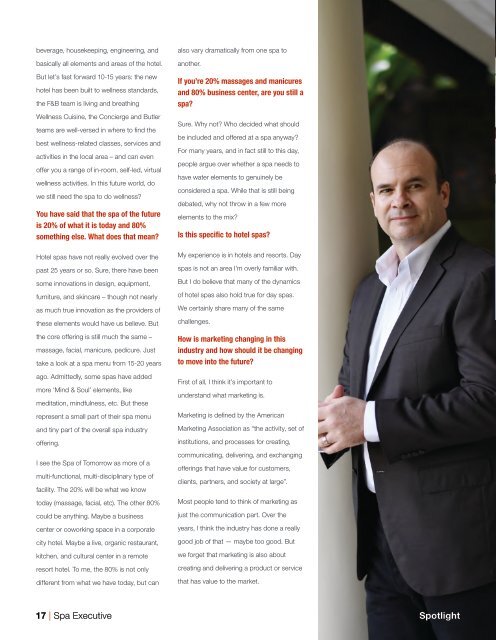You also want an ePaper? Increase the reach of your titles
YUMPU automatically turns print PDFs into web optimized ePapers that Google loves.
everage, housekeeping, engineering, and<br />
basically all elements and areas of the hotel.<br />
But let’s fast forward 10-15 years: the new<br />
hotel has been built to wellness standards,<br />
the F&B team is living and breathing<br />
Wellness Cuisine, the Concierge and Butler<br />
teams are well-versed in where to find the<br />
best wellness-related classes, services and<br />
activities in the local area – and can even<br />
offer you a range of in-room, self-led, virtual<br />
wellness activities. In this future world, do<br />
we still need the spa to do wellness?<br />
You have said that the spa of the future<br />
is 20% of what it is today and 80%<br />
something else. What does that mean?<br />
Hotel spas have not really evolved over the<br />
past 25 years or so. Sure, there have been<br />
some innovations in design, equipment,<br />
furniture, and skincare – though not nearly<br />
as much true innovation as the providers of<br />
these elements would have us believe. But<br />
the core offering is still much the same –<br />
massage, facial, manicure, pedicure. Just<br />
take a look at a spa menu from 15-20 years<br />
ago. Admittedly, some spas have added<br />
more ‘Mind & Soul’ elements, like<br />
meditation, mindfulness, etc. But these<br />
represent a small part of their spa menu<br />
and tiny part of the overall spa industry<br />
offering.<br />
I see the <strong>Spa</strong> of Tomorrow as more of a<br />
multi-functional, multi-disciplinary type of<br />
facility. The 20% will be what we know<br />
today (massage, facial, etc). The other 80%<br />
could be anything. Maybe a business<br />
center or coworking space in a corporate<br />
city hotel. Maybe a live, organic restaurant,<br />
kitchen, and cultural center in a remote<br />
resort hotel. To me, the 80% is not only<br />
different from what we have today, but can<br />
also vary dramatically from one spa to<br />
another.<br />
If you’re 20% massages and manicures<br />
and 80% business center, are you still a<br />
spa?<br />
Sure. Why not? Who decided what should<br />
be included and offered at a spa anyway?<br />
For many years, and in fact still to this day,<br />
people argue over whether a spa needs to<br />
have water elements to genuinely be<br />
considered a spa. While that is still being<br />
debated, why not throw in a few more<br />
elements to the mix?<br />
Is this specific to hotel spas?<br />
My experience is in hotels and resorts. Day<br />
spas is not an area I’m overly familiar with.<br />
But I do believe that many of the dynamics<br />
of hotel spas also hold true for day spas.<br />
We certainly share many of the same<br />
challenges.<br />
How is marketing changing in this<br />
industry and how should it be changing<br />
to move into the future?<br />
First of all, I think it’s important to<br />
understand what marketing is.<br />
Marketing is defined by the American<br />
Marketing Association as “the activity, set of<br />
institutions, and processes for creating,<br />
communicating, delivering, and exchanging<br />
offerings that have value for customers,<br />
clients, partners, and society at large”.<br />
Most people tend to think of marketing as<br />
just the communication part. Over the<br />
years, I think the industry has done a really<br />
good job of that — maybe too good. But<br />
we forget that marketing is also about<br />
creating and delivering a product or service<br />
that has value to the market.<br />
17 | <strong>Spa</strong> <strong>Executive</strong> Spotlight


















